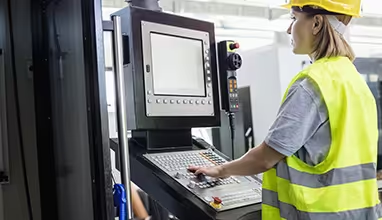A CNC machinist works with a variety of computer-controlled or mechanically-controlled machines in order to create precision metal parts and tools. They may work for different types of machine shops or tool manufacturers to create the products that those shops and manufacturers sell. The job outlook for a CNC machinist is not as good as most other industries, but individuals can still find great opportunities and pay.
The Industry as a Whole
CNC machinists have a technical knowledge and experience that most other professionals do not, so their unique services are valuable. However, there are a limited number of positions available, so competition among CNC machinists will be quite high. As of the year 2010, there were just over 430,000 CNC machinists employed across the nation and that number is expected to grow by 29,900 through the year 2020, according to the Bureau of Labor Statistics. This makes a total of around 467,000 CNC machinist jobs in the year 2020.
The Future of CNC Machinists
The Bureau of Labor Statistics estimates that employment as a CNC machinist will climb by just 7% through the year 2020. This rate is much slower than most other industries, and the 7% represents less than 30,000 new jobs available over a span of 10 years. This means that CNC machinists will have high competition in the field when searching for jobs. Often, this can lead to fewer opportunities and a lower pay rate. However, with the right training and experience, machinists can still find a great position with good pay.
What Causes Growth?
For CNC machinists, growth in the industry would be directly related to the need for more precision cut tools and metal parts. Typically, this means that manufacturers would have to grow first, based on consumer demand of certain products. However, since many manufacturing jobs are outsourced to other countries, the need within the US is reduced. More US-based companies and a higher demand for quality items from manufacturers can cause the industry grow and create more jobs for CNC machinists.
Job Availability
Because the industry is growing at a slower than average rate, machinists who can operate a variety of computers and machines within a warehouse will be most valued. Those who are limited to one or two will not experience the kind of success that someone with knowledge of more systems might have. Gaining experience by training in an apprenticeship program or attending vocational courses can increase your opportunities, as can higher education levels and more experience. Making yourself useful in various ways in a warehouse can also increase your opportunities.
Places of Work
According to the Bureau of Labor Statistics, machine shops account for more than 28% of employment in this industry. This includes screw, nut and bolt manufacturing. Coming in second is metalwork machinery manufacturing, which accounts for 14.65% of employment within the industry. The remaining places of work include employment services, motor vehicle parts manufacturing and aerospace product and parts manufacturing.
Individuals considering going into this field will have more luck in states like Texas, California, Georgia, North Carolina and New York. These states account for large percentages of employed CNC machinists while states like Alaska, Nevada and Wyoming have much smaller numbers of employed machinists.






